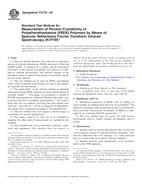Potrebujeme váš súhlas na využitie jednotlivých dát, aby sa vám okrem iného mohli ukazovať informácie týkajúce sa vašich záujmov. Súhlas udelíte kliknutím na tlačidlo „OK“.
ASTM D1238-13
Standard Test Method for Melt Flow Rates of Thermoplastics by Extrusion Plastometer
Automaticky preložený názov:
Štandardná skúšobná metóda pre Melt prietoky termoplastov vytlačovaním plastometr
NORMA vydaná dňa 1.8.2013
Informácie o norme:
Označenie normy: ASTM D1238-13
Poznámka: NEPLATNÁ
Dátum vydania normy: 1.8.2013
Kód tovaru: NS-16723
Počet strán: 16
Približná hmotnosť: 48 g (0.11 libier)
Krajina: Americká technická norma
Kategória: Technické normy ASTM
Kategórie - podobné normy:
Anotácia textu normy ASTM D1238-13 :
Keywords:
melt flow rate, melt index, volume flow rate, ICS Number Code 83.080.20 (Thermoplastic materials)
Doplňujúce informácie
| Significance and Use | ||||||||||||||
|
4.1 This test method is particularly useful for quality control tests on thermoplastics. 4.2 The data produced by this test method serves to indicate the uniformity of the flow rate of the polymer as made by an individual process. It is not to be used as an indication of uniformity of other properties without valid correlation with data from other tests. 4.3 The flow rate obtained with the extrusion plastometer is not a fundamental polymer property. It is an empirically defined parameter critically influenced by the physical properties and molecular structure of the polymer and the conditions of measurement. The rheological characteristics of polymer melts depend on a number of variables. It is possible that the values of these variables occurring in this test will differ substantially from those in large-scale processes, which would result in data that does not correlate directly with processing behavior. 4.4 Measure the flow rate of a material using any of the conditions listed for the material in 4.5 Additional characterization of a material can be obtained if more than one condition is used. In the case that two or more conditions are employed, a Flow Rate Ratio (FRR) is obtained by dividing the flow rate at one condition by the flow rate at another condition. Procedure D provides one method to measure more than one condition in a single charge. 4.6 Frequently, variations in test technique, apparatus geometry, or test conditions, which defy all but the most careful scrutiny, exist, causing discrepancies in flow rate determinations. A troubleshooting guide is found in 1.1 This test method covers the determination of the rate of extrusion of molten thermoplastic resins using an extrusion plastometer. After a specified preheating time, resin is extruded through a die with a specified length and orifice diameter under prescribed conditions of temperature, load, and piston position in the barrel. Four procedures are described. Comparable results have been obtained by these procedures in interlaboratory round-robin measurements of several materials and are described in Section 15. 1.2 Procedure A is used to determine the melt flow rate (MFR) of a thermoplastic material. The units of measure are grams of material/10 minutes (g/10 min). It is based on the measurement of the mass of material that extrudes from the die over a given period of time. It is generally used for materials having melt flow rates that fall between 0.15 and 50 g/10 min (see Note 1). 1.3 Procedure B is an automatically timed measurement used to determine the melt flow rate (MFR) as well as the melt volume rate (MVR) of thermoplastic materials. MFR measurements made with Procedure B are reported in g/10 minutes. MVR measurements are reported in cubic centimetres/ten minutes (cm3/10 min). Procedure B measurements are based on the determination of the volume of material extruded from the die over a given period of time. The volume is converted to a mass measurement by multiplying the result by the melt density value for the material (see Note 2). Procedure B is generally used with materials having melt flow rates from 0.50 to 1500 g/10 min. 1.4 Procedure C is an automatically timed measurement used to determine the melt flow rate (MFR) of polyolefin materials. It is generally used as an alternative to Procedure B on samples having melt flow rates greater than 75 g/10 min. Procedure C involves the use of a modified die, commonly referred to as a “half-die,” which has half the height and half the internal diameter of the standard die specified for use in Procedures A and B thus maintaining the same length to diameter ratio. The test procedure is similar to Procedure B, but the results obtained with Procedure C shall not be assumed to be half of those results produced with Procedure B. 1.5 Procedure D is a multi-weight test commonly referred to as a “Flow Rate Ratio” (FRR) test. Procedure D is designed to allow MFR determinations to be made using two or three different test loads (either increasing or decreasing the load during the test) on one charge of material. The FRR is a dimensionless number derived by dividing the MFR at the higher test load by the MFR at the lower test load. Results generated from multi-weight tests shall not be directly compared with results derived from Procedure A or Procedure B. 1.6 This standard does not
purport to address the safety concerns, if any, associated with its
use. It is the responsibility of the user of this standard to
establish appropriate safety and health practices and determine the
applicability of regulatory limitations prior to use.
|
||||||||||||||
| 2. Referenced Documents | ||||||||||||||
|
Podobné normy:
Historická
1.4.2012
Historická
10.9.2002
Historická
1.6.2009
Historická
15.11.2010
Historická
15.11.2009
Historická
1.6.2010



 ASTM F1867-06(2012)..
ASTM F1867-06(2012).. ASTM F1871-11
ASTM F1871-11 ASTM F1925-09
ASTM F1925-09 ASTM F1947-10
ASTM F1947-10 ASTM F2778-09
ASTM F2778-09 ASTM F2848-10
ASTM F2848-10
 Cookies
Cookies
